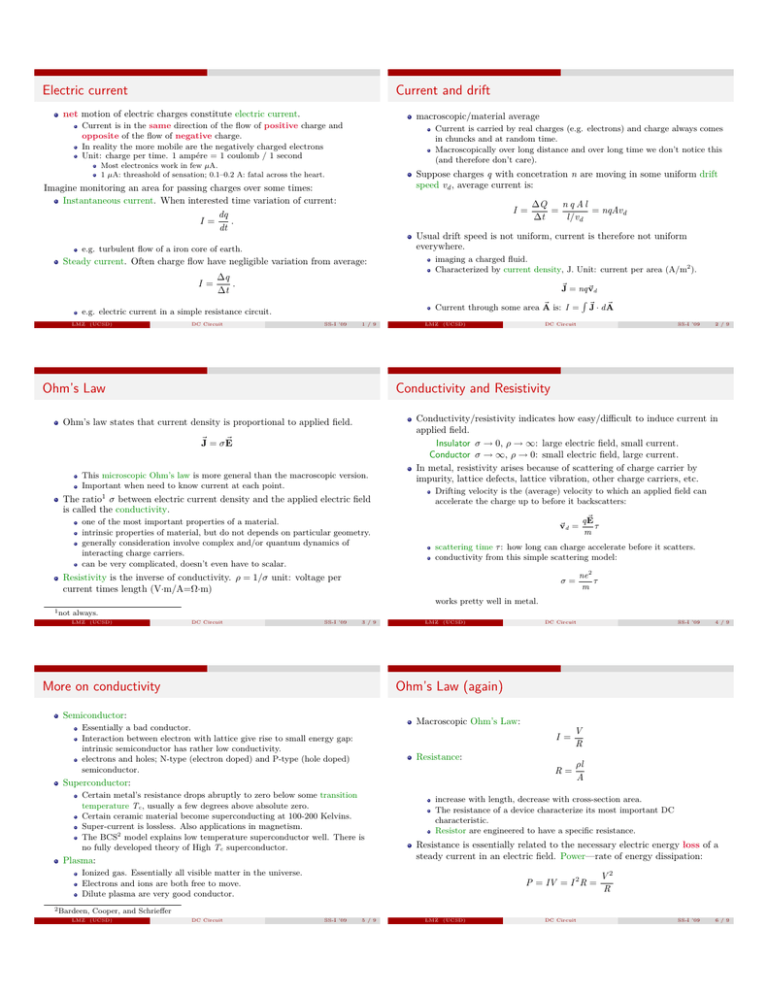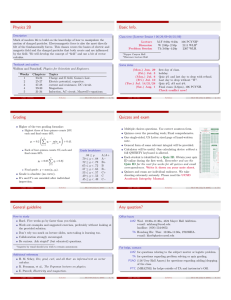Electric current Current and drift net motion of electric charges constitute
advertisement

Electric current Current and drift net motion of electric charges constitute electric current. macroscopic/material average Current is in the same direction of the flow of positive charge and opposite of the flow of negative charge. In reality the more mobile are the negatively charged electrons Unit: charge per time. 1 ampére = 1 coulomb / 1 second Current is carried by real charges (e.g. electrons) and charge always comes in chuncks and at random time. Macroscopically over long distance and over long time we don’t notice this (and therefore don’t care). Most electronics work in few µA. 1 µA: threashold of sensation; 0.1–0.2 A: fatal across the heart. Suppose charges q with concetration n are moving in some uniform drift speed vd , average current is: Imagine monitoring an area for passing charges over some times: Instantaneous current. When interested time variation of current: dq I = . dt I = Usual drift speed is not uniform, current is therefore not uniform everywhere. e.g. turbulent flow of a iron core of earth. Steady current. Often charge flow have negligible variation from average: ∆q I = . ∆t DC Circuit imaging a charged fluid. Characterized by current density, J. Unit: current per area (A/m2 ). ~J = nq~vd ~ is: I = Current through some area A e.g. electric current in a simple resistance circuit. LMZ (UCSD) n q Al ∆Q = = nqAvd ∆t l/vd SS-I ’09 1 / 9 Ohm’s Law LMZ (UCSD) R ~J · d A ~ DC Circuit SS-I ’09 2 / 9 Conductivity and Resistivity Ohm’s law states that current density is proportional to applied field. ~J = σ E ~ This microscopic Ohm’s law is more general than the macroscopic version. Important when need to know current at each point. The ratio1 σ between electric current density and the applied electric field is called the conductivity. one of the most important properties of a material. intrinsic properties of material, but do not depends on particular geometry. generally consideration involve complex and/or quantum dynamics of interacting charge carriers. can be very complicated, doesn’t even have to scalar. Conductivity/resistivity indicates how easy/difficult to induce current in applied field. Insulator σ → 0, ρ → ∞: large electric field, small current. Conductor σ → ∞, ρ → 0: small electric field, large current. In metal, resistivity arises because of scattering of charge carrier by impurity, lattice defects, lattice vibration, other charge carriers, etc. Drifting velocity is the (average) velocity to which an applied field can accelerate the charge up to before it backscatters: ~vd = ~ qE τ m scattering time τ : how long can charge accelerate before it scatters. conductivity from this simple scattering model: Resistivity is the inverse of conductivity. ρ = 1/σ unit: voltage per current times length (V·m/A=Ω·m) ne 2 τ m σ= works pretty well in metal. 1 not always. LMZ (UCSD) DC Circuit SS-I ’09 3 / 9 More on conductivity LMZ (UCSD) SS-I ’09 4 / 9 Ohm’s Law (again) Semiconductor: Macroscopic Ohm’s Law: Essentially a bad conductor. Interaction between electron with lattice give rise to small energy gap: intrinsic semiconductor has rather low conductivity. electrons and holes; N-type (electron doped) and P-type (hole doped) semiconductor. I = V R R= ρl A Resistance: Superconductor: Certain metal’s resistance drops abruptly to zero below some transition temperature Tc , usually a few degrees above absolute zero. Certain ceramic material become superconducting at 100-200 Kelvins. Super-current is lossless. Also applications in magnetism. The BCS2 model explains low temperature superconductor well. There is no fully developed theory of High Tc superconductor. Plasma: increase with length, decrease with cross-section area. The resistance of a device characterize its most important DC characteristic. Resistor are engineered to have a specific resistance. Resistance is essentially related to the necessary electric energy loss of a steady current in an electric field. Power—rate of energy dissipation: Ionized gas. Essentially all visible matter in the universe. Electrons and ions are both free to move. Dilute plasma are very good conductor. 2 Bardeen, DC Circuit P = IV = I 2 R = V2 R Cooper, and Schrieffer LMZ (UCSD) DC Circuit SS-I ’09 5 / 9 LMZ (UCSD) DC Circuit SS-I ’09 6 / 9 Resistance Kirchoff’s Rules Most general configuration of circuit do not neatly break into either series or parallel connections. Kirchoff’s (loop) voltage rule: the voltage difference of any complete loop is zero. H Resistors in parallel: same voltages: V1 = V2 = V3 = · · · current add: Itotal = I1 + I2 + I3 + · · · inverse of resistance adds: ~ being conservative: Result of E 1 1 1 1 = + + + ··· Rtotal R1 R2 R3 Resistors in series: Result of conservation or charge same current: I1 = I2 = I3 = · · · voltage add: Vtotal = V1 + V2 + V3 + · · · resistance adds: Rtotal = R1 + R2 + R3 + · · · How to use Kirchoff’s rules: 1 2 Some other devices: 3 ideal battery/voltage source has zero internal resistance. ideal voltmeter has infinite input resistance. ideal ammeter has zero input resistance. real devices are not ideal. 4 5 Identify loops and nodes in a circuit. Identify each current branch3 . Labeling the polarity on each component will be helpful. For each node, the sum of current going minus thesum of current going out is zero. For each loop, the sum of potential difference of each component with the correct polarity is zero. Solve the system of linear equations 3 Correct LMZ (UCSD) DC Circuit SS-I ’09 7 / 9 RC circuits Capacitor do not charge up or discharge instantaneously. Charge is delivered by current. current—rate of charge—decreases as capacitor become more charged/discharged and is proportional to the voltage on the resistor. I = I0 e −t/RC As capacitor charges up and VC increases, the VR decreases, so I decreases, so charging slows down: VC = V0 [1 − exp−t/τ ] with time constant or RC constant: τ = RC . Discharging is exactly the opposite. VC = V0 exp−t/τ Behavior of capacitor: Behaves like a short when it starts to charge/discharge Behaves like an open when it completely charges/discharges. LMZ (UCSD) ~ · d~l = 0 or ∇ ~ = 0. ~ ×E E Kirchoff’s (node) current rule: the sum of current into and out of a node is zero. DC Circuit SS-I ’09 9 / 9 choice of direction is nice but not required. LMZ (UCSD) DC Circuit SS-I ’09 8 / 9







